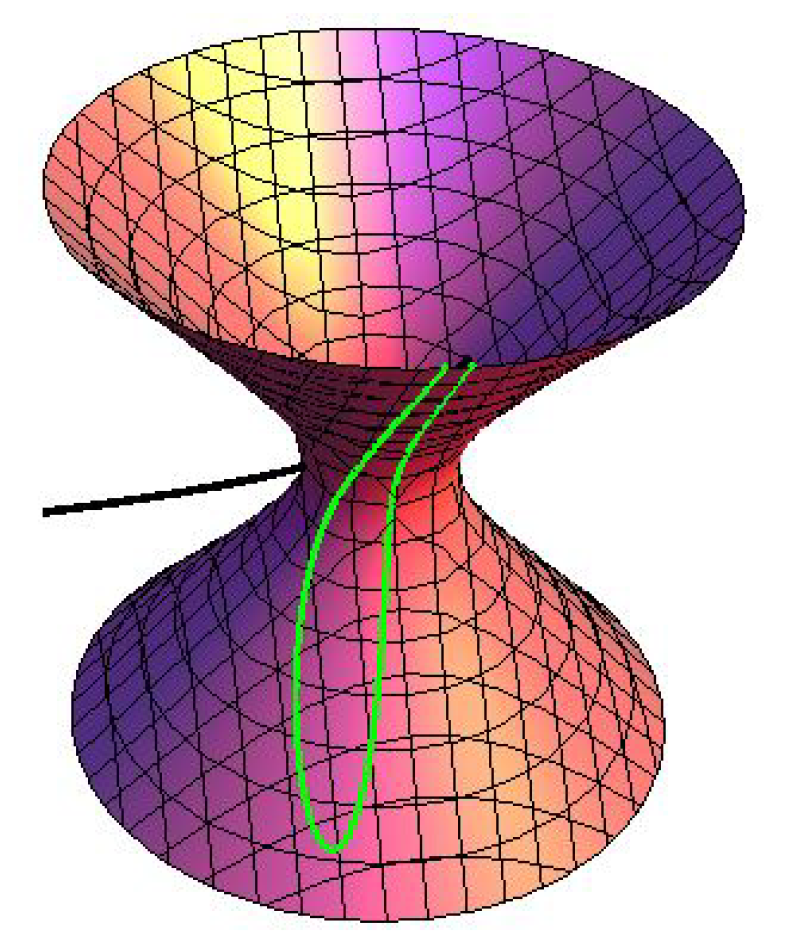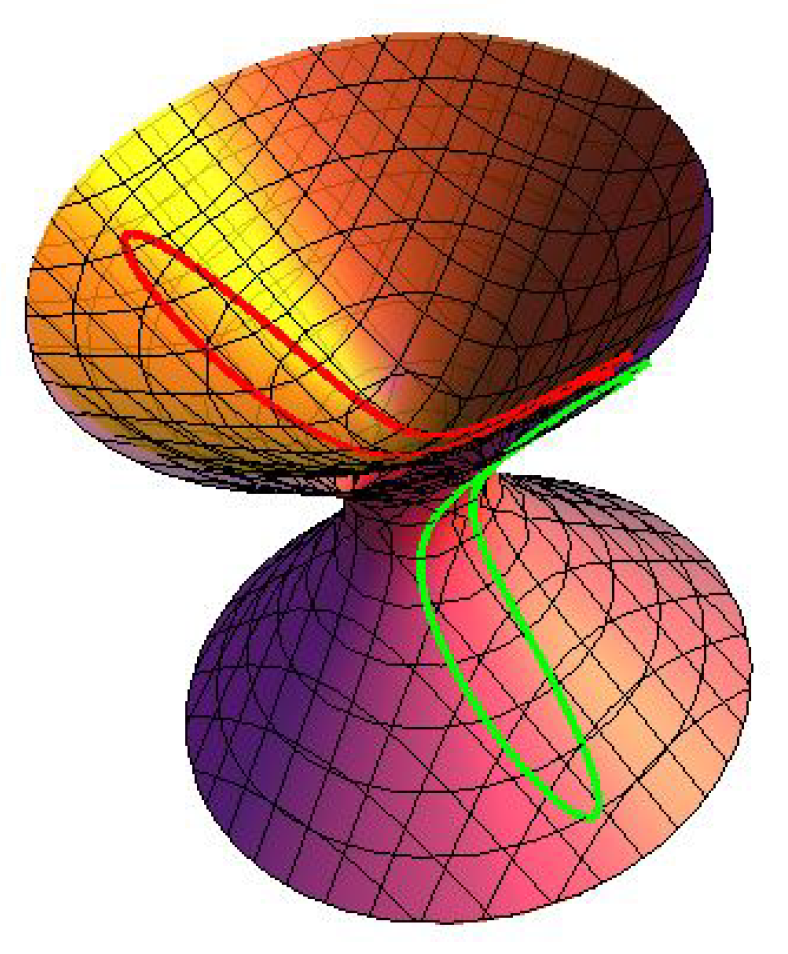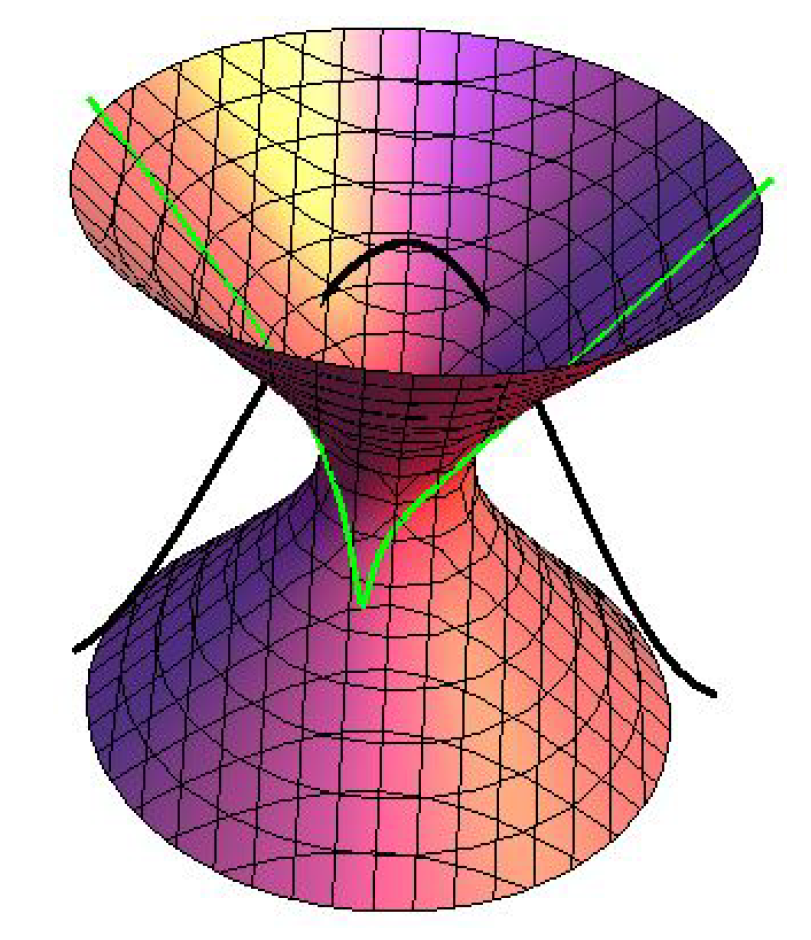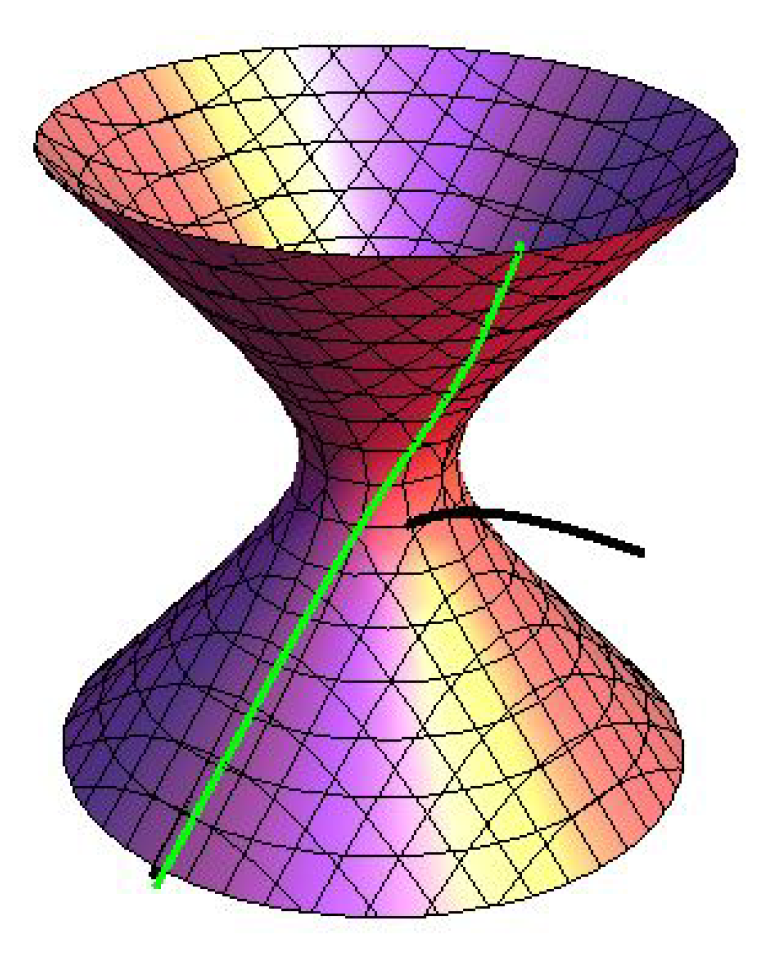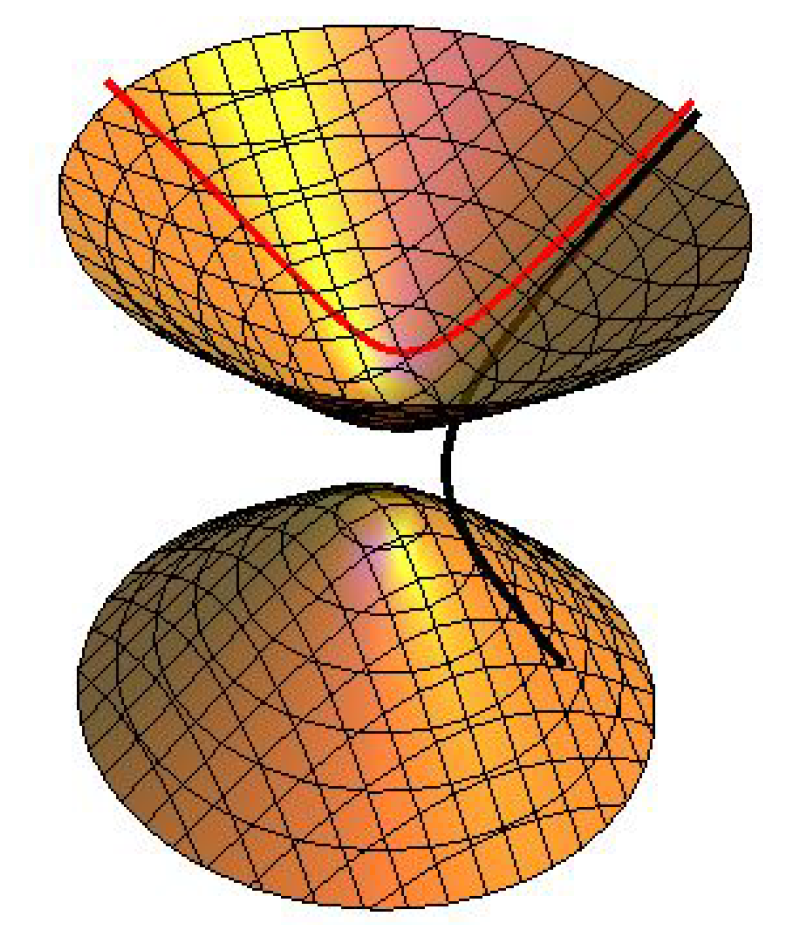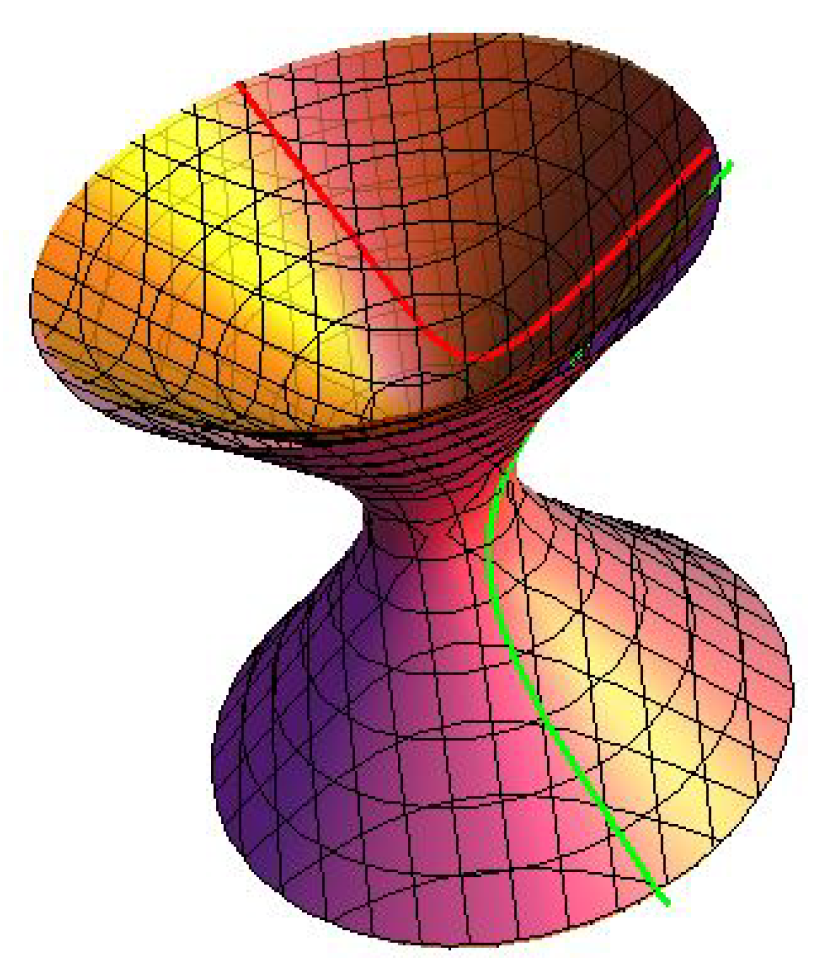1. Introduction
In differential geometry, the space associate curves for which there exist some relations between their Frenet frames or curvatures compose a large class of fascinating subjects in the curve theory, such as Bertrand curve, Mannheim curve, central trace of osculating sphere, involute-evolute curves etc. [
1,
2,
3]. Most of the researchers aimed to explore the relationships between the partner curves. For example, in Euclidean 3-space, the classical Bertrand curves are characterized by constant distance between the corresponding points of the partner curves and by constant angle between tangent vector fields of the partner curves. Naturally, the idea of partner curves research can be moved to other spaces, such as Lorentz-Minkowski space, Galilean space and so on.
The Lorentz-Minkowski metric divides the vectors into spacelike, timelike and lightlike (null) vectors [
4]. Due to the causal character of vectors, some simple problems become a little complicated and strange, such as the arc-length of null curves can not be defined similar to the definition in Euclidean space; the angles between different type of vectors need to be classified according to different conditions [
5,
6]. In Minkowski space, the curves are divided into spacelike, timelike and lightlike (null) curves according to the causal character of their tangent vectors. Some particular curves such as the helix, the Bertrand curve, the Mannheim curve and the normal curve, the osculating curve and the rectifying curve have been surveyed by some researchers [
5,
7,
8,
9,
10,
11,
12].
Based on pseudo null curves in Minkowski 3-space, in this work, we define a kind of normal partner curves of a pseudo null curve which lies on de-Sitter space and hyperbolic space, respectively. In
Section 2, some fundamental facts about the pseudo null curves, the space forms and the angles between any two non-null vectors are recalled. In
Section 3, the relationships between a pseudo null curve and its normal partner curves on dual space forms are explicitly expressed by some particular function and the angles between their tangent vector fields. Furthermore, the relationships between the normal partner curves of a pseudo null curve are presented through the pseudo null curve. Last but not least, some useful and interesting examples of pseudo null curves and their normal partner curves are shown vividly.
The curves in this paper are regular and smooth unless otherwise stated.
2. Preliminaries
The Minkowski 3-space
is provided with the standard indefinite flat metric given by
in terms of the natural coordinate system
. Recall that a vector
v is said to be spacelike, timelike and lightlike (null), if
or
,
and
,
, respectively. The norm (modulus) of
v is defined by
. For any two vectors
,
, the vector product is given by
where
is an orthogonal basis in
.
An arbitrary curve
can locally be spacelike, timelike or lightlike (null) if all of its velocity vectors
are spacelike, timelike or lightlike, respectively. Furthermore, the spacelike curves can be classified into three kinds according to their principal normal vectors are spacelike, timelike or lightlike, which are called the first and the second kind of spacelike curve and the pseudo null curve, respectively [
13]. Among of them, the pseudo null curve is defined as the following.
Definition 1. ([
6]).
A spacelike curve framed by Frenet frame in is called a pseudo null curve, if its principal normal vector N and binormal vector B are linearly independent lightlike (null) vectors. Proposition 1. ([
6]).
Let be a pseudo null curve parameterized by arc-length s, i.e., . Then there exists a unique Frenet frame such thatwhere and In sequence, is called the tangent, principal normal and binormal vector fields of , respectively. The function is called the pseudo null curvature of .
Remark 1. ([
8]).
Every pseudo null curve in is planar no matter the value of the pseudo null curvature. The authors of [
14] characterized pseudo null curves with the structure function as the following.
Proposition 2 ([
14]).
Let be a pseudo null curve in . Then and its pseudo null curvature can be written aswhere , is non-constant function which is called the structure function of .
Definition 2 ([
15]).
Let p be a fixed point in and be a constant. Then the pseudo-Riemannian space forms, i.e., the de-Sitter space , the hyperbolic space and the lightlike cone are defined asThe point p is called the center of , and . When p is the origin and , we simply denote them by , and .
For a pseudo null curve
framed by
in
, the planes spanned by
,
and
are known as the osculating, the rectifying and the normal planes of
, respectively. A curve
is called an associate osculating, an associate rectifying, or an associate normal curve of
when the position vector
always lies on the osculating, the rectifying, or the normal plane of
, respectively. For an associate normal curve
of a pseudo null curve
, we can write
for some non-zero differentiable functions
and
. In particular, if the associate normal curve
lies on
or
, then
and
satisfy
or
. Without lose of generality, we have the following definition.
Definition 3. Let be a pseudo null curve framed by in . Then , is called an associate normal curve of on de-Sitter space, an associate normal curve of on hyperbolic space for some non-zero differentiable function , respectively. In a word, and are called normal partner curves of on dual space forms.
To serve the discussions, some fundamental facts of curves lying on space forms will be reviewed.
Proposition 3 ([
15]).
Let be a curve parameterized by arc-length s. Then there exists a unique pseudo spherical Frenet frame such thatwhere , The function is called the pseudo spherical curvature of .
Proposition 4 ([
15]).
Let be a curve parameterized by arc-length s. Then there exists a unique hyperbolic Frenet frame such thatwhere , The function is called the hyperbolic curvature of .
At last, let us recall the notion of angles between two arbitrary non-null vectors in .
Definition 4 ([
16]).
Let u and v be spacelike vectors in . Definition 5 ([
16]).
Let u be a spacelike vector and v a future pointing timelike vector in . Then there is a unique non-negative real number θ such thatThe real number θ is called the Lorentz timelike angle between u and v.
Definition 6. [16] Let u and v be future pointing (past pointing) timelike vectors in . Then there is a unique non-negative real number θ such that The real number θ is called the Lorentz timelike angle between u and v.
Remark 2 ([
6]).
Physically, this designation of the future pointing and past pointing timelike vectors corresponds to a choice of an arrow of time at the given point, therefore Equations (6) and (7) include all definitions of angles between non-null vectors and timelike vectors. Remark 3. The angles between a lightlike vector and an arbitrary spacelike vector, timelike vector or another lightlike vector which is independent to it have been defined in [6]. We do not recall the details here, because they are not involved in this paper. 3. Main Conclusions
In this section, the associate normal curves of a pseudo null curve on de-Sitter space and hyperbolic space, respectively will be discussed. At the same time, the relationships between the normal partner curves will be presented.
3.1. Associate Normal Curves of a Pseudo Null Curve on de-Sitter Space
Let be a pseudo null curve framed by , its associate normal curve on de-Sitter space framed by . From Proposition 3, we have
Case (1):
, i.e.,
is spacelike. In order to distinguish different cases, we rewrite Equation (
2) as the following:
where
is the arc-length of
, and
,
Taking derivative on both sides of
with respect to the arc-length
s of
, we get
where
. Making inner product on both sides of Equation (
8) with itself, we get
. Then, we have
substituting it into Equation (
8), we get
Due to
are spacelike vectors and
is spacelike, then
T and
span a timelike subspace. According to Equation (
4), we have
where
is the Lorentz timelike angle between
T and
. Together with
, we get
, thus
. Explicitly, when
,
; when
,
. Then, Equation (
10) can be rewritten as
Differentiating Equation (
11) with respect to
s and by Equation (
9), we have
Taking inner product on both sides of Equation (
12) with itself, we get
considering
and
, by Equation (
13) we have
Then, by substituting Equation (
14) and
into Equation (
12), we can obtain
Case (2):
, i.e.,
is timelike. Similar to the process of Case 1, we can rewrite Equation (
2) as the following:
where
is the arc-length of
, and
,
Taking derivative on both sides of
with respect to the arc-length
s of
, we get
where
. Making inner product on both sides of Equation (
15) with itself, we get
. Then, we have
substituting it into Equation (
15), we get
Due to
T is spacelike,
is timelike, according to Equation (
6), we have
where
is the Lorentz timelike angle between
T and
Together with
, we get
thus
(
). Explicitly, when
,
; when
,
. Then, Equation (
17) can be rewritten as
Differentiating Equation (
18) with respect to
s and by Equation (
16), we have
Taking inner product on both sides of Equation (
19) with itself, we get
considering
and
by Equation (
20) we have
Then, by substituting Equation (
21) and
into Equation (
19), we can obtain
Based on above discussions, we can get the following conclusions.
Theorem 1. Let be a pseudo null curve framed by , its associate normal curve on de-Sitter space framed by .
If is spacelike, then the Frenet frame of and the pseudo spherical Frenet frame of can be related by as or the Lorentz timelike angle between T and as where , , and when , ; when , .
If is timelike, then the Frenet frame of and the pseudo spherical Frenet frame of can be related by as or the Lorentz timelike angle between T and as where , , and when , ; when , .
Theorem 2. Let be a pseudo null curve framed by , its associate normal curve on de-Sitter space framed by .
If is spacelike, the pseudo spherical curvature of can be expressed by If is timelike, the pseudo spherical curvature of can be expressed by
where ϵ, , and f as stated in Theorem 1.
It is obvious that the case
is excluded in the first case of Theorems 1 and 2. In fact, when
, i.e.,
, by solving the differential equation, we get
Furthermore, from Equation (
1), by substituting
into above equation, we have
Corollary 1. Let be a pseudo null curve framed by with pseudo null curvature and structure function , its associate normal curve on de-Sitter space framed by . If , then we have
the arc-length of can be expressed by ;
the pseudo spherical curvature of is ;
the Frenet frame of and the pseudo spherical Frenet frame of can be related by
Proof of Corollary 1. When
, by taking derivative on both sides of
with respect to the arc-length
s of
, we get
Making inner product on both sides of Equation (
22) with itself, we get
. Then, we get
Obviously, the arc-length
from Equation (
23). Substituting Equation (
23) into Equation (
22), we get
Taking derivative on both sides of Equation (
24) with respect to
s and by Equation (
23), we have
Making inner product on both sides of Equation (
25) with itself, we have
. Then from
and Equation (
25), we can obtain
The proof is completed. □
Remark 4. Obviously, the corresponding results in Theorems 1 and 2 still hold for , i.e., .
3.2. Associate Normal Curves of a Pseudo Null Curve on Hyperbolic Space
Let
be a pseudo null curve framed by
,
its associate normal curve on hyperbolic space framed by
. From Proposition 4, we can rewrite Equation (
3) as the following:
where
is the arc-length of
, and
,
Taking derivative on both sides of
with respect to the arc-length
s of
, we get
where
. Making inner product on both sides of Equation (
26) with itself, we get
. Then, we have
substituting it into Equation (
26), we get
Due to
are spacelike vectors and
is timelike, then
T and
span a spacelike subspace. According to Equation (
5), we have
where
is the Lorentz spacelike angle between
T and
. Together with
, we can get
, thus
Explicitly, when
; when
. Then, Equation (
28) can be rewritten as
Differentiating Equation (
29) with respect to
s and by Equation (
27), we have
Taking inner product on both sides of Equation (
30) with itself, we get
considering
and
, by Equation (
31) we have
Then, by substituting Equation (
32) and
into Equation (
30), we can obtain
Summarize above discussions, we have the following conclusions.
Theorem 3. Let be a pseudo null curve framed by , its associate normal curve on hyperbolic space framed by . Then the Frenet frame of and the hyperbolic Frenet frame of can be related by as or the Lorentz spacelike angle between T and as where , , and when ; when .
Theorem 4. Let be a pseudo null curve framed by , its associate normal curve on hyperbolic space framed by . Then the hyperbolic curvature of can be expressed by where ϵ, , and f as stated in Theorem 3.
Similar to the procedure of the associate normal curve of a pseudo null curve on de-Sitter space , for the associate normal curve of a pseudo null curve on hyperbolic space , when , i.e., , we have the following conclusions.
Corollary 2. Let be a pseudo null curve framed by with pseudo null curvature and structure function , its associate normal curve on hyperbolic space framed by . If , then we have
the arc-length of can be expressed by ;
the hyperbolic curvature of is ;
the Frenet frame of and the hyperbolic Frenet frame of can be related by
Remark 5. The proof of Corollary 2 is omitted here since it is very similar to Corollary 1. Obviously, the results in Theorems 3 and 4 still hold for , i.e., .
3.3. The Relationships of the Normal Partner Curves
In this section, we state the relations of the normal partner curves on dual space forms using the knowledge of linear algebra and the results obtained in
Section 3.1 and
Section 3.2.
Theorem 5. Let be a pseudo null curve framed by , framed by and framed by be normal partner curves of on dual space forms.
If is spacelike, then the pseudo spherical Frenet frame of and the hyperbolic Frenet frame of can be related by as or the Lorentz timelike angle between T and , the Lorentz spacelike angle between T and as where , , and , as stated in Theorems 1 and 3, respectively. and when , ; when , .
If is timelike, then the pseudo spherical Frenet frame of and the hyperbolic Frenet frame of can be related by as or the Lorentz timelike angle between T and , the Lorentz spacelike angle between T and as
where , , and , as stated in Theorems 1 and 3, respectively. and when , ; when , .
Proof of Theorem 5. From Theorems 1 and 3, by some matrix calculations, it is easy to get the conclusions. □
At the same time, from Theorems 2 and 4, the following conclusions are straightforward.
Theorem 6. Let be a pseudo null curve framed by , framed by and framed by be normal partner curves of on dual space forms. Then the pseudo spherical curvature of and the hyperbolic curvature of satisfy
if is spacelike, , then we have and they are related by , when , ; when , . and as stated in Theorems 1 and 3, respectively;
if is timelike, , then we have and they are related by when , ; when , . and as stated in Theorems 1 and 3, respectively.
Considering Corollaries 1 and 2, when , i.e., , we have the following conclusions.
Corollary 3. Let be a pseudo null curve framed by with pseudo null curvature and structure function , framed by and framed by be normal partner curves of on dual space forms. If , then we have
Remark 6. In Corollaries 1–3, for a given pseudo null curve , when the smooth function , the pseudo spherical curvature of and the hyperbolic curvature of . How about the converse statement? i.e., when a pseudo spherical curve with spacelike normal vector field has pseudo spherical curvature or a hyperbolic curve has hyperbolic curvature , how to find out the corresponding pseudo null curve and what is the relationship between the smooth function and the null curvature function or the structure function of ? These problems are still in the air and can be considered in the future.
